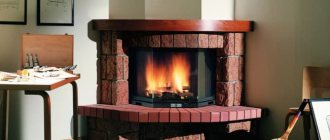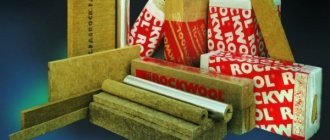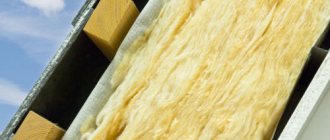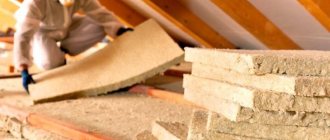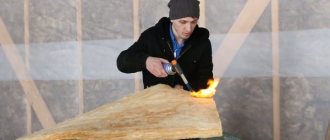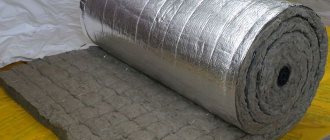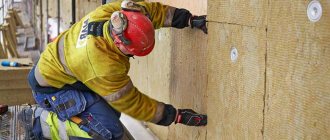Why do you need to insulate the chimney?
Effective insulation of the chimney will prevent it from cooling quickly.
In addition, traction improves and the likelihood of condensation formation decreases.
Insulation of the chimney is indirect, but still prevents heating of the building structures.
Basically, measures for insulating chimney pipes are carried out with the chimneys of gas boilers.
Chimney insulation design
The insulated chimney has a sandwich-like appearance. This design includes two pipes - external and internal, between which there is basalt insulation for chimney pipes.
Such a structure will help prevent the formation of condensation. In the manufacture of the inner pipe, which bears heavy loads from the interaction of combustion products, high-quality steel is used.
The outer pipe is decorative. For its manufacture, copper, stainless steel or any other material coated with colored enamel is used.
But with an industrial chimney everything is a little different. As a thermal insulation material, you need to use insulation that can withstand temperatures up to 4,000 degrees.
Such material should also provide protection for the outer skin, since the constant influence of temperatures and temperature changes can negatively affect the outer (cement) layer.
Does basalt wool insulate a chimney?
Based on the high insulating qualities, resistance to aggressive environments and thermal heating of basalt wool, we can safely give a positive answer.
When choosing a brand of insulating material for a chimney, pay attention to the density of basalt wool - it should be very dense and exhibit minimal shrinkage when heated and during operation.
In addition to chimney insulation, mineral wool cushions are used, consisting of several layers, reinforced with a metal layer.
The chimney can be made of metal, asbestos-cement pipe, or brick. To improve the efficiency of the heat generator and protect it from fire, install heat-insulating, heat-resistant material.
Basalt wool is used as a heat insulator for the chimney. It helps reduce heat loss through the chimney, as well as protect walls and ceilings from overheating.
Features of thermal protection products
When choosing non-flammable raw materials for construction work, you should pay attention to its characteristics, composition and features. Depending on these indicators, a means of insulating the floor, ceiling, pipes or other structures is selected.
The defining characteristic of the raw material for insulation is also its thickness. This indicator influences the choice of heat-insulating material for highways, air ducts and other structures that require precise calculations during their construction. Density and weight also influence the choice; the calculation of the load on the floors of structures depends on these indicators.
Useful properties of basalt insulation
Using basalt insulation from floors and walls for a chimney will help reduce material consumption, the diameter of the chimney, and reduce its weight, while maintaining efficiency and safety.
The good water-repellent qualities and vapor permeability of basalt insulation make it possible to avoid the formation of condensation in the chimney, which helps to increase the efficiency and reliability of the entire heating system.
As a rule, basalt wool for chimneys can withstand high temperatures for quite a long time, since the binders used in its manufacture do not decompose when heated.
Based on the basic requirements for insulation, you should select the brand of basalt insulation for the chimney. Also pay attention to the strength and density of the material that will be used to line the chimney.
Basalt wool, which is used as a heat insulator, will not shrink at high temperatures. To insulate the chimney from the load-bearing wall, use multi-layer mineral wool pads reinforced with metal. They should be fixed to the walls where the chimney pipe is laid.
Thus, basalt wool is a fireproof material for a chimney that meets fire safety standards and requirements.
It is a popular and sought-after material that is widely used both for chimney insulation and for other purposes.
Non-combustible thermal insulation is used not only where there is a potential for ignition, but also for any type of insulation. But there are situations when such material is simply irreplaceable, we are talking about non-flammable insulation for a chimney. Regarding the use of non-combustible insulation for walls, floors and roofs, one thing can be said - caution is never superfluous.
Expert advice
Builders advise choosing thermal protection according to the following criteria:
- fibrous base, light weight;
- ready-made stainless steel sleeves;
- resistant base to high and temperature changes, covered with foil;
- the internal diameter must be larger than the outlet of the heating device.
Install a smoke exhaust channel according to the rules. It is also worth taking advice from experts. Thermal insulation is carried out according to the following standards:
- thermal insulation must be applied in a continuous layer, without transitions, especially in places of contact with the ceiling and roof;
- mats and strips are laid only with the markings facing outwards;
- installation of parts is carried out from the bottom up, overlapping, the lower end is covered with the upper connection;
- internal insulation is carried out in stages, during installation of the structure, external insulation after complete assembly;
- a spark arrester is installed at the end if the roof consists of flammable materials;
- use personal protective equipment.
The rules are simple; following them will help prolong the operation of the output channel.
Non-combustible chimney insulation
Only mineral wool is used to insulate the chimney.
Why insulate the chimney, because it is already hot? Let's start with the fact that it only needs to be insulated outdoors or in an unheated room. It is not necessary to do this indoors, although it is not prohibited.
The most common non-flammable insulation for chimneys is mineral wool in rolls (glass wool, basalt wool). It can withstand high temperatures, does not burn or smolder, and therefore does not emit any toxic gases. Also read: “How to insulate a chimney pipe.”
Non-flammable thermal insulation for pipes is needed to prevent condensation from forming in the chimney due to the temperature difference between the exhaust gases and the air outside. The presence of condensation leads to the following consequences:
- destruction of the chimney; failure of the boiler; icing.
The greater the thickness of non-flammable thermal insulation for pipes, the more effective the insulation, and at the same time the temperature difference and the amount of condensate are minimized.
It is not recommended to use materials thinner than five centimeters. Rolled insulation is wound around the pipe with a slight overlap and secured with soft wire.
The external insulation must be protected with foil or sheet metal. There are ready-made steel sandwich chimneys on sale, which consist of two tin pipes of different diameters, with mineral wool between them. Remember that non-flammable pipe insulation is afraid of moisture and, having absorbed it, loses its heat transfer resistance characteristics.
Chemically active liquid for flushing heating boilers is also suitable for cleaning pipes and radiators. Along with dirt, it also corrodes rust, so often after work is carried out, a leak appears in the system. You can read about what kind of antifreeze liquid to pour into the heating system here.
Application of bricks
One of the old methods of making non-combustible thermal insulation for metal pipes involves the use of broken refractory or clay bricks.
In this case, a steel casing was created around the pipe so that the gap between it and the pipe was about 50-100 mm. The broken brick is poured into this gap. The brick does not need to be compacted and compacted to create thermal gaps. This method of insulation is inexpensive, because it practically does not require special purchase of materials. The disadvantage is the large weight of the entire pipe structure, which negates all other advantages of metal chimneys - quick erection, mobility, the ability to create any configuration.
Fireproof thermal insulation for walls
Applying liquid polyurethane foam to walls.
Ideally, non-flammable wall insulation should always be used when it comes to thermal insulation of load-bearing structures. According to the rules of heating engineering, work should be carried out from the outside and only as a last resort from the inside. For these purposes, the choice of materials is quite wide:
If previously the most popular non-flammable insulation for walls was mineral wool, today it has greatly lost its position in favor of modern liquid thermal insulation. We are talking about polyurethane foam and penoizol, and insulating paint, although it is positioned as a non-flammable insulation for the facade, is in fact only suitable for thermal insulation of communications.
Bulk materials for horizontal structures are applicable not only during construction, when they can fill the space between walls. After the structure is erected, it can be blown out through the holes made in the wall. Bulk non-flammable thermal insulation for walls fills all the cracks, in principle, like liquid insulation, but the latter has its advantages:
- it is lighter; lower thermal conductivity coefficient; reasonable price; possibility of application to a wall, for example, on a facade.
Foam glass is still the most expensive material among fireproof thermal insulation.
It comes in granules, stones (like crushed stone) and blocks. Granules and blocks are used for walls. The former are filled into inter-wall cavities, and the latter are used to construct protective structures on the façade side.
The blocks are quite strong, but still cannot act as load-bearing elements. Due to their high cost, such materials are used only on large objects. They are almost never used for private houses, since the insulation will turn out to be simply golden.
After cleaning the heat exchangers, the liquid for heating radiators must be neutralized with a special solution and only then poured into the sewer. Non-freezing liquid for a heating system in a warm house only thickens even at -60. You will find its characteristics here.
Where is it used?
Various types of non-combustible insulation are used in the construction industry:
- for facade systems;
- when installing roofs and ceilings;
- for exterior decoration of house walls;
- when installing chimneys and stoves; in the construction of a bathhouse;
- for insulating pipes in various communication networks.
The climate in most regions of our country makes the selection of heat-insulating products with fire protection an urgent problem.
Non-combustible thermal insulation for horizontal floors
Expanded clay can be laid under a wooden floor or screed.
When talking about horizontal floors, we mean:
The methods for installing insulation on these structures are the simplest, and no loads are applied to the materials. Therefore, any of the above materials is suitable as a non-combustible floor insulation. Preference is given to those that do not harbor mice.
As you know, rodents cause many problems, especially in the countryside. In the house where you live permanently, this problem can be solved quite simply - you need to get a cat. In a country house, all that remains is to either catch mice with traps or poison them.
Both options are losing.
Mice breed so quickly that traps can take a long time to kill them. Adding poison risks causing the rodent to die in its burrow, that is, under the floor, resulting in a strong odor. Mice will not start in:
- vermiculite, perlite and expanded clay, even mixed 50/50 with sawdust; polyurethane foam and penoizol; granulated foam glass.
To select non-flammable insulation for the roof, you need to start from the roof structure. If it is almost horizontal with a slight slope, then, if desired, you can even use bulk insulation. If the slope is significant, then only mineral wool or liquid thermal insulation is suitable.
Bulk
Bulk insulation materials are expanded clay, perlite, vermiculite, which are very resistant to fire and have a flammability class of at least G1 - an oxygen index of at least 30%.
Expanded clay is obtained by firing clay. The granules are heavy and have high thermal conductivity. This non-flammable thermal insulation is of a loose type and is therefore inconvenient to install. However, it is cheap and environmentally friendly. Expanded clay is characterized by the size of the fractions. So, up to 5 mm is sand, up to 40 mm is gravel. If large fractions are crushed, the result is crushed stone.
Thermal and fire-resistant qualities when using expanded clay are significantly increased. This is especially true for hard-to-reach places where such insulation can simply be poured. Expanded vermiculite is used for walls in low-rise construction. It is resistant to microorganisms, environmentally friendly, but has low moisture resistance.
Perlite
Perlite comes in the form of volcanic glass granules. The fraction ranges from 1 to 10 mm. Thanks to its light weight and the ability to adjust the thickness of the protective layer, it serves as an excellent heat insulator.
In practice, 30 mm of perlite is equivalent in effect to 150 mm of brick. Perlite is suitable for thermal insulation of roofs and walls and can be an alternative to brickwork. The disadvantage is that it absorbs moisture well and is fragile.
